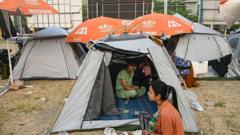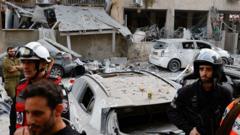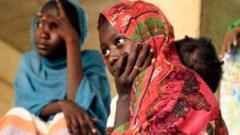Following a significant earthquake in Myanmar, military authorities have hindered aid access, leading to rising casualties and a humanitarian crisis. Despite a call for international aid from junta leader Min Aung Hlaing, the reality on the ground reveals a complicated and dangerous intertwining of military strategy and humanitarian need.
The Duality of Relief: How Myanmar's Junta Manipulates Aid in Crisis

The Duality of Relief: How Myanmar's Junta Manipulates Aid in Crisis
In the aftermath of a devastating earthquake, the military junta in Myanmar is accused of obstructing humanitarian efforts and weaponizing aid to control resistance-held regions.
The recent earthquake in Myanmar has exposed the deepening crisis as humanitarian efforts face severe roadblocks imposed by the military regime. With over 2,700 fatalities reported, the 7.7 magnitude quake has strained the already fragile conditions for aid delivery in the country.
Despite junta chief Min Aung Hlaing's public appeal for international assistance shortly after the disaster, grassroots reports highlight significant obstacles posed by military authorities. According to John Quinley, director of the human rights group Fortify Rights, access to affected areas in Sagaing and Mandalay was severely restricted, with military checkpoints impeding the flow of vital aid during the critical 72-hour rescue window.
Furthermore, violence erupted on Tuesday night when a convoy of the Chinese Red Cross carrying life-saving supplies was fired upon by military forces, illustrating the junta's alarming propensity to hostilely intervene in humanitarian operations. These actions aren't isolated; past disaster responses have seen the military systematically channeling aid only to areas under their control, effectively weaponizing humanitarian relief as a punitive measure against dissenting populations.
James Rodehaver from the Office of the UN’s High Commissioner for Human Rights regards these tactics as deliberate attempts to undermine local support for resistance groups, exacerbating the crisis in regions that resist military governance. Reports from agencies reveal acute shortages of essential supplies in affected areas due to imposed military restrictions, leaving many victims in distress and vulnerable.
Civil society organizations have cried out for international scrutiny to prevent aid from being diverted through military channels, insisting that assistance reaches those in genuine need, particularly in the hands of local pro-democracy groups. The emphasis lies on avoiding the past mistakes where aid inadvertently bolstered the junta's control over crisis-stricken citizens.
As volunteers step in where formal aid entities falter, reports indicate that community-led initiatives are handling the rescue efforts, often relying on makeshift resources. Still, bureaucratic hurdles imposed by the junta complicate these efforts, demanding exhaustive permissions for any relief to materialize.
While some humanitarian leaders harbor hopes that the international response to this catastrophe might pressure the junta to ease restrictions, skepticism remains high. Military airstrikes following the earthquake compounded concerns, with Min Aung Hlaing's contradictory governance prompting questions about the junta's intentions in allowing aid.
For many observers, the current state of affairs marks a dire need to critically assess how aid is delivered in Myanmar, ensuring that efforts focus on genuinely assisting those impacted by the quake rather than acting as tools for military leverage. John Quinley asserts that vigilance is essential in ensuring that relief truly reaches the communities most in need, rather than being utilized for ulterior motives within the junta's complex power play.























